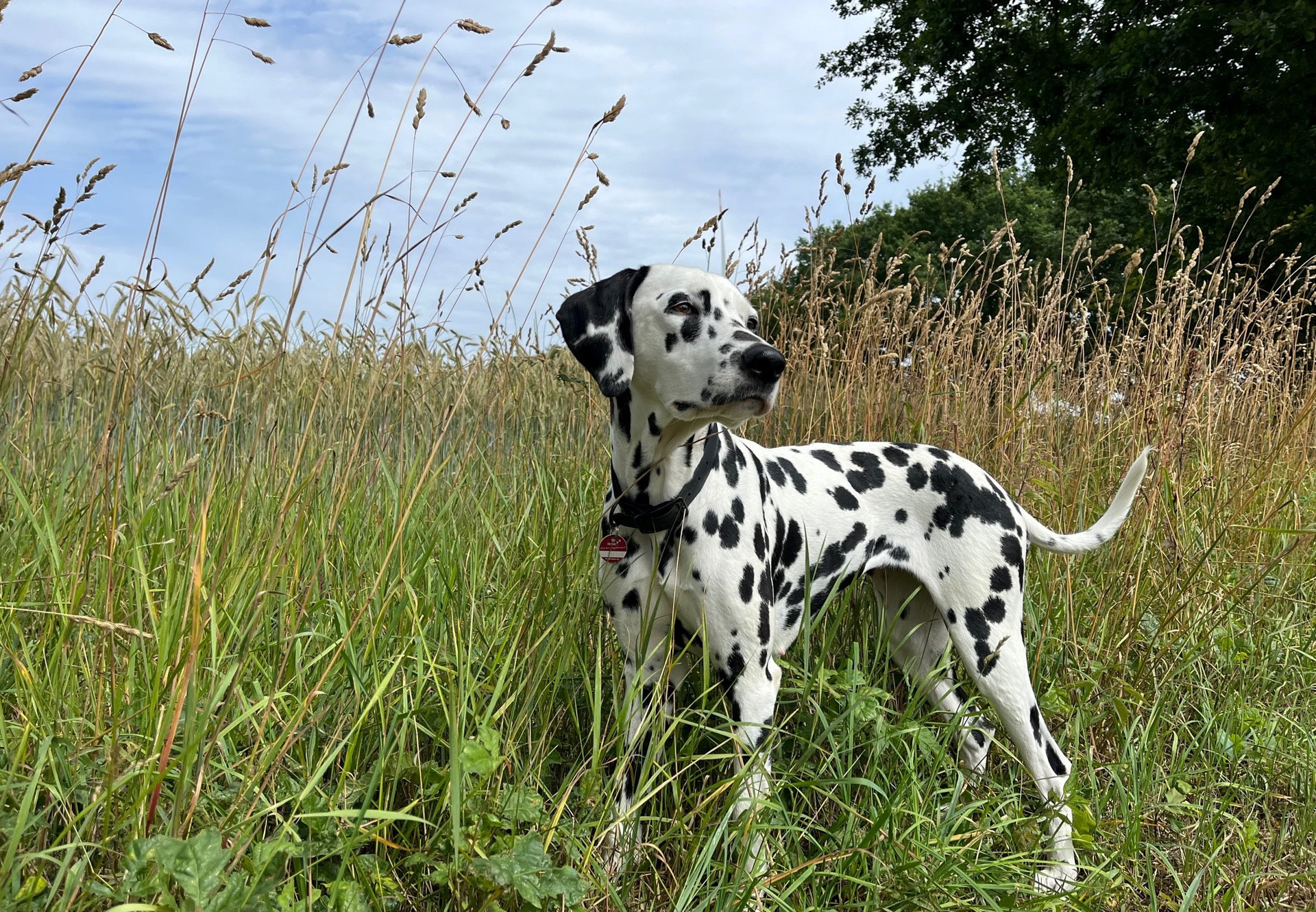
Awns: Why They Pose a Great Danger to Dogs
Avoid tall grasses and fields of cereal crops to protect your dog
Awns are stiff, sharp parts of plants that grow from grasses such as cereals (including rye, oat, wheat and barley) various grasses like false barley, oat grass and other plant families1,2. They are equipped with many small barbs pointing backwards, which enable the awns to attach themselves quickly to a dog’s fur and which only allow movement in one direction – towards, towards the animal’s body³. Having anchored themselves to the coat, the awns work their way deeper into the fur every time the dog moves. With their sharp tips, awns are able to puncture the animal’s skin and become lodged there, where they can cause infections, inflammation and abscesses. These foreign bodies can also enter your dog’s body through orifices such as the nose, mouth and ears4, resulting in internal injury. For example, they can travel through the gastrointestinal or respiratory tract, where they can cause life-threatening damage5,6. It is therefore very important to check the entire dog after every walk. Examine the paws, especially the area between the toes, as the awns often penetrate and bore into the skin, which is very painful and can also become inflamed. The awns may have to be removed by surgery.
Learn more about
Found an awn in your dog's fur?
Remove each awn you find. If you find an awn that is snagged in your dog’s fur or that has only partially penetrated the skin, you may be able to remove it yourself (using tweezers if necessary). However, if the awn has already worked its way deeper into the skin, you must take your dog to the vet so it can be removed properly and the necessary medication can be administered (e.g. anti-inflammatory drug, painkiller, antibiotic). If the vet has reason to think an awn is already inside your dog’s body, more extensive veterinary measures will be needed (physical examination, diagnostic testing, biopsies and diagnostic imaging like ultrasound)7.
Signs to Look Out For
The telltale signs that your dog has an awn problem will vary depending on where the foreign body is located.
- In the ear:
Your dog scratches their ear (which may be inflamed) and shakes their head increasingly. They may hold their head at an angle. Fluid may come out of the ear, and you may notice an unpleasant smell8,9. - In the nose:
Your dog sneezes repeatedly or has symptoms including nasal secretions, nosebleeds, infection and pain1 (e.g. expressed by restless behaviour, whining, whimpering, frantic scratching/rubbing of the nose, etc.). If there is inflammation or swelling in the upper respiratory tract, your dog may also have difficulty breathing10. - In the eye:
If it is lodged in the conjunctival sac of the eye, an awn can cause watery eyes (lacrimation), sensitivity to light and excessive blinking. Your dog may show their discomfort by rubbing the affected eye more than usual1. - In the paw (between the toes):
Your dog licks and bites increasingly the affected paw. You may notice a limp. Your dog may also show signs of pain when you examine the paw (e.g. pulling the paw away, licking your hand or even defensive behaviour and/or growling when you examine the paw). If the awn is already buried inside the paw, you may see a small hole where the foreign body entered. You may also see discharge (pus)11. - In the trachea or lungs:
If your dog develops a sudden and persistent cough, becomes short of breath or coughs up sputum, then an awn may be the culprit10,11. Whether an awn is the trigger or not, take your dog to a veterinary practice and have it examined. - Our advice to you: Search all areas of the chest, abdomen, loin and flank as carefully as possible, as the awns can pierce through to the internal organs in these areas. This can be life-threatening and lead to urgent emergency surgery. In some cases, you have to look closely, as the entry points can be mistaken for (large) mosquito or insect bites.
Consequences
The potential consequences for your dog can be extremely serious and quickly even life-threatening.
- If an awn isn’t removed from the ear in time, it can lead to middle-ear infection, loss of balance and rupture of the eardrum10,12.
- An awn in the paw can cause abscesses and infections between the affected toes13.
- If left untreated, awns in the eye can lead to severe corneal damage and, in the worst cases, blindness11,14.
- Awns can cause infections in the nose. If they travel through the nasal cavities to the brain, they can prove fatal15.
- If left untreated, awns in the trachea or lungs can lead to pneumonia or pneumothorax (a build-up of air between the lungs and the chest wall)5.
Preventive measures
Try not to let your dog run through tall grass or beside fields of cereal crops at the height of the awn season (June – August). If necessary, keep your dog’s coat and the fur around their paws trimmed short, and brush out their undercoat. If – despite your best efforts – your dog does come into contact with tall grass, keep a close eye out for any of the warning signs listed above. Check your dog thoroughly for awns and remove them immediately.
Conclusion
Although you and your dog may enjoy walking beside a gently swaying cornfield or through tall grass, you should take great care in the awn season. Switch to wooded areas or meadows without grasses. Awns may be small, but they could put your dog’s life in danger. Being aware of the risks will help you protect your dog during your walks together.
Source
2. Ntakirutimana F, Xie W. Unveiling the Actual Functions of Awns in Grasses: From Yield Potential to Quality Traits. International Journal of Molecular Sciences. 2020;21(20):7593. doi:10.3390/ijms21207593
3. Foxtail Plants: How to Find Them on Dogs and Why They’re So Dangerous. [accessed 2024 Jun 18]. https://www.petmd.com/dog/care/how-protect-your-dog-foxtails
4. Flisi S, Dall’Aglio M, Spadini C, Cabassi CS, Quintavalla F. Microbial Isolates from Vegetable Foreign Bodies Inhaled by Dogs. Veterinary Medicine International. 2018;2018:3089282. doi:10.1155/2018/3089282
5. Pneumothorax in Dogs | VCA Animal Hospital. Vca. [accessed 2022 Jul 12]. https://vcahospitals.com/know-your-pet/pneumothorax-in-dogs
6. Spontaneous Pneumothorax. American College of Veterinary Surgeons. [accessed 2024 Jun 18]. https://www.acvs.org/small-animal/spontaneous-pneumothorax/
7. Young A. Foxtails and Dogs | Animal Health Topics / School of Veterinary Medicine. 2023 May 8 [accessed 2024 Jun 18]. https://healthtopics.vetmed.ucdavis.edu/health-topics/foxtails
8. How to Identify, Treat, and Prevent Dog Ear Infections. [accessed 2022 Jul 12]. https://www.petmd.com/dog/conditions/how-treat-and-prevent-dog-ear-infections
9. Clinic SA. Ear Infections in Dogs (Canine Otitis Externa) | Sandia Animal Clinic. [accessed 2022 Jul 12]. https://www.sandiaanimalclinic.com/2020/08/01/ear-infections-in-dogs-canine-otitis-externa/
10. Foxtail Grass Foreign Body in Domestic Animals. Pet Poison Helpline. 2019 Aug 23 [accessed 2022 Jul 4]. https://www.petpoisonhelpline.com/blog/foxtail-grass-foreign-body-in-domestic-animals/
11. Why are grass seeds dangerous for dogs? Vet Help Direct. 2021 [accessed 2022 Jul 4]. https://vethelpdirect.com/vetblog/2021/06/03/why-are-grass-seeds-dangerous-for-dogs/
12. Otitis Media and Interna in Animals - Ear Disorders. MSD Veterinary Manual. [accessed 2024 Jun 18]. https://www.msdvetmanual.com/ear-disorders/otitis-media-and-interna/otitis-media-and-interna-in-animals
13. Interdigital Furunculosis in Dogs - Integumentary System. MSD Veterinary Manual. [accessed 2024 Jun 18]. https://www.msdvetmanual.com/integumentary-system/interdigital-furunculosis/interdigital-furunculosis-in-dogs
14. Grass seed in dogs, what to do if seeds are lodged in your dog’s paws, ears or skin? Vets Now. [accessed 2022 Jul 4]. https://www.vets-now.com/pet-care-advice/grass-seed-in-dog/
15. Brain Inflammation Due to Parasitic Infection in Dogs. [accessed 2022 Jul 12]. https://www.petmd.com/dog/conditions/neurological/c_dg_encephalitis_secondary_to_parasitic_migration
 Please be careful! If you delete this page, consider that it could be used within an other language version.
Please be careful! If you delete this page, consider that it could be used within an other language version.
